
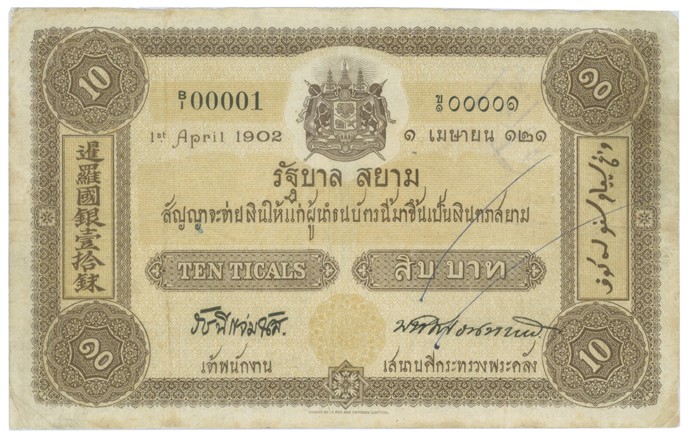
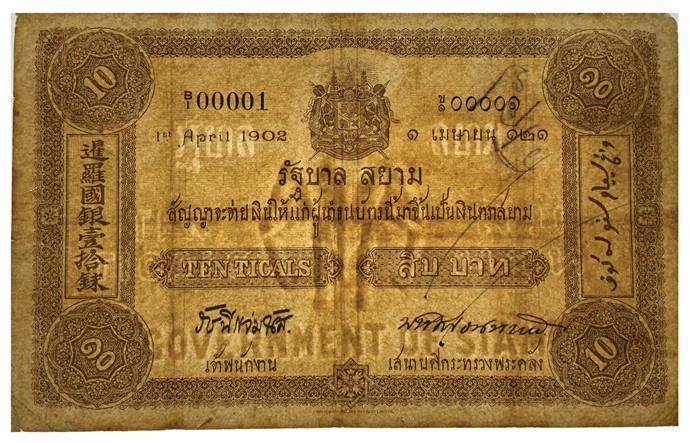
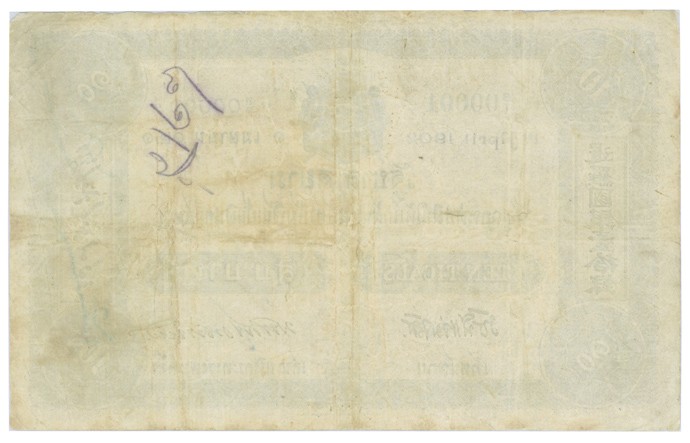
10 Ticals 1st April 1902 with double outline
In 1901 one of Mr. W.J.F. Williamson duties as a Financial Adviser to the Siamese Ministry of Finance was to arrange for the printing of banknotes for the Kingdom of Siam. He discussed with Sir Thomas de la Rue the question of whether it was advisable to have the notes printed on both sides or to have the back plain.
It was agreed to have the back plain so the watermark could be more visible. This was one of the principal points relied upon for safeguarding the Siamese notes against forgery. In the first years, the notes were printed on watermarked paper with a double outline. The watermarked paper showed the three-headed elephant, the legend GOVERNMENT OF SIAM, and the denominations in Thai and Roman alphabets.
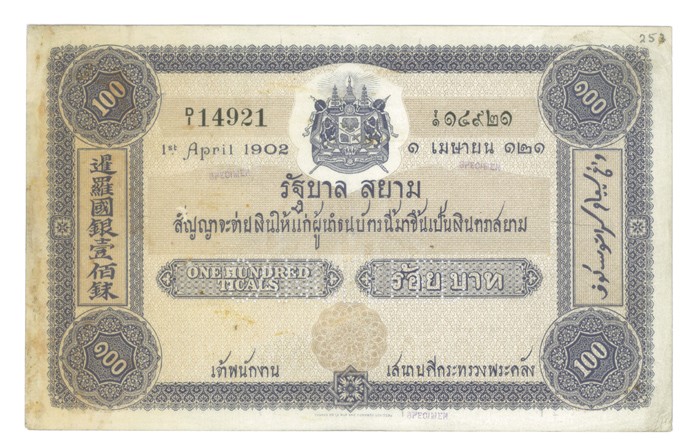
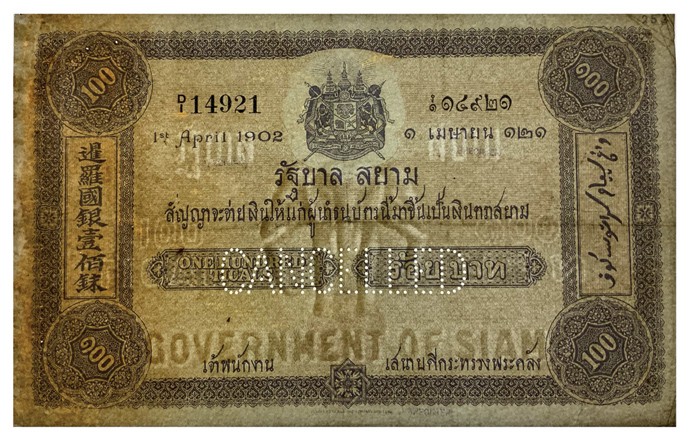
100 Ticals 1st April 1902 with double outline
On the 25th of April 1907, His Excellency Phya Suriyanuwatr, Minister of Finance in Bangkok, sent a telegram to Thomas de la Rue & Company Limited London: “Last supply notes 20 and 10 ticals watermark very poor letter follows = Suriya”.
In the letter the Minister enclosed three specimens of the notes supplied by Thomas de la Rue & Company Limited London (TdlR) in May 1907 shipped per S.S. “City of Delhi” and “Nubia”. Enclosed was also a 10 Tical note from the last supply shipped per S.S. “Formosa”. From the enclosed note there could be seen according to the Minister that ‘the paper was getting thicker and thicker and the watermark more and more indistinct’.
The Minister also informed that the crispness of the notes was lessened. Some of the 20 Baht notes had been through inadvertence by the Paper Currency Office been put in circulation. It was adverse comments from the public which led to the opaqueness of the paper being noticed. The defective notes would be returned to TdlR for inspection and destruction.
The 50,000 Ten Tical notes on hand were rejected as well the 50,000 already shipped. Immediate steps had to be taken and a fresh supply had to be printed with the same prefix B/4 and the numbers 00001 – 100000.
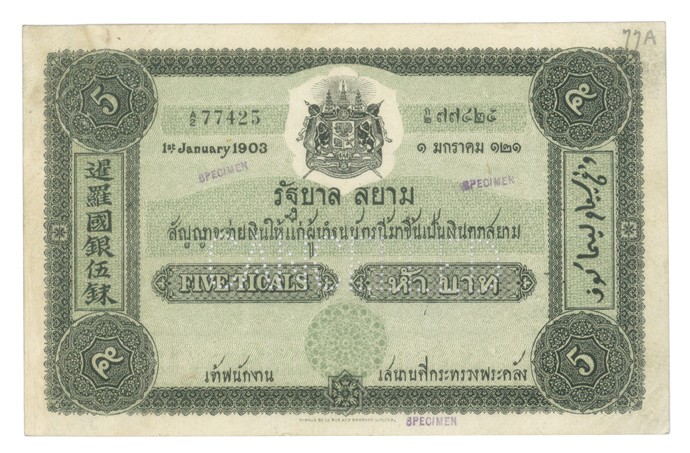
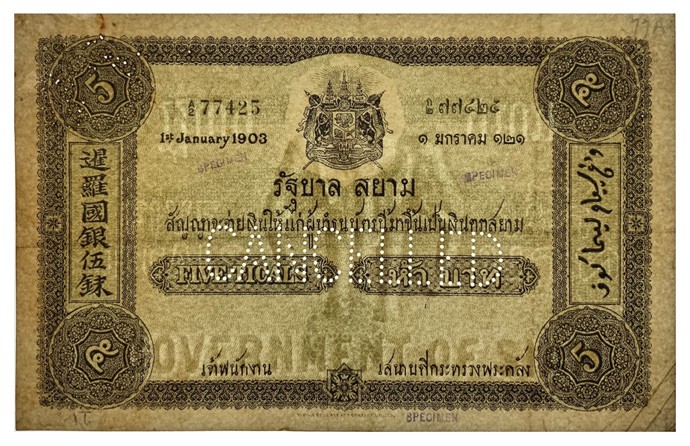
5 Baht 1st January 1903 with double outline and microscopic printing
In reply to the Minister on 31st May 1907, TdlR said that the watermark was not sufficiently distinct because of the more intricate overprint with microscopic printing and that the paper had been coated with a thin preparation. TdlR feared that in some instances the paper had been too thickly coated and also too highly glazed, which would cause the watermark to be indistinct.
TdlR included three cancelled specimen notes where the printing was satisfactory and the watermark sufficiently defined. TdlR was prepared to replace, free of charge, any notes the Ministry of Finance would return. Printing of replacement 10 Tical notes would start as soon as a telegram was received with the Minister’s decision.
In a letter dated 10th June 1907, the Siamese Minister in London, H.E. Phya Visutr Kosa, informed TdlR that it was the intention of His Majesty’s Government that future consignments of currency shall be ordered from your firm through the Legation in London. The Siamese Minister in London would be in the position to determine whether the watermark and printing of future consignments would be up to the standards required by the Siamese Government.
The Minister in London proposed that TdlR furnish him with three specimens marked A, B and C of each denomination prior to printing a new series. The specimen marked B should be exactly similar regarding watermark, and distinctness of impression and quality of paper with the notes hitherto supplied to Bangkok and found satisfactory. The Specimen marked A should be of thinner and crispier paper, while specimen C should be of thicker paper than specimen B.
One of the specimens should be kept by the Minister in London, one should be sent to the Ministry of Finance and the third returned signed as approved to TdlR. It was very understandable that the Minister in London was not so confident being the one to approve all future Siamese Banknotes. A diplomat had probably never expected to be in charge of watermarks and the printing of the countries banknotes.
A couple of days later, TdlR informed the Minister in London that it would not be feasible to start a machine to print the notes and send the specimens to the Minister in London before proceeding with the order. TdlR would instead send the Minister in London some cancelled specimens as soon as they had commenced printing them.
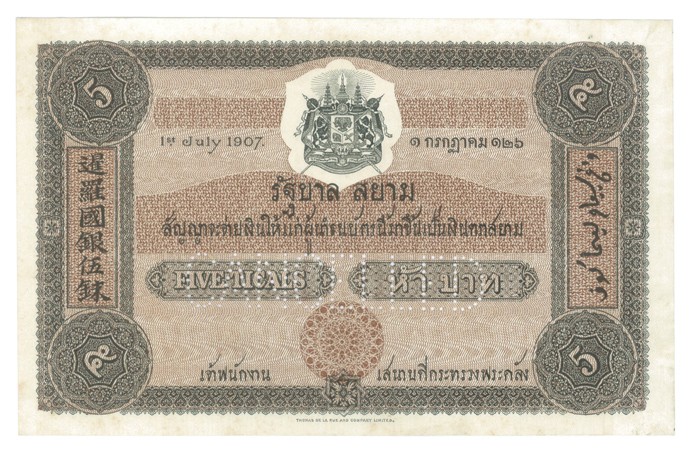

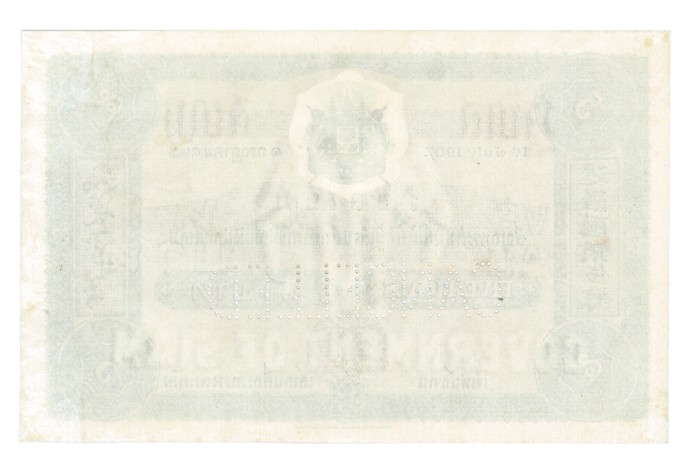
5 Baht 1907 with double outline and microscopic printing. This note was sent to the Ministry of Finance in Siam and returned to TdlR
Mr. Charles James Rivett-Carnac, who had been the advisor to the Ministry of the Royal Treasury, now the Financial Agent of His Siamese Majesty’s Government, had in 1900 introduced the possibility to replace coins with banknotes.
At the request of The Siamese Minister in London, H.E. Phya Visutr Kosa, Mr Rivett-Carnac had a meeting with the Managing Director of TdlR on the 9th of June 1907. At the meeting, discussions were held regarding the problems with the watermark and the thickness and crispness of the banknotes.
It was agreed at the meeting that the Minister in London was to be sent three cancelled specimens of the 5 Tical notes identical to specimens sent to Siam, which were identical to the suggested adaptations. TdlR waited for a wire from the Siamese Government whether they approved of the recommendation, and if so, all future notes would be supplied with the specimens sent to Siam along with those sent to the Minister in London.
His Excellency Phya Suriyanuwatr, Minister of Finance in Bangkok, sent a telegram on the 17th of July 1907 to TdlR saying, “Referring to your letter of 31st May, the specimens have my approval. Suriya”. In a letter sent on the same day the Minister of Finance expressed that he was not altogether satisfied with the crispness of the paper or the clearness of the watermark.
TdlR was asked to give the matter further attention whether any improvement could be effected in these respects. The Minister of Finance kept one of the three 5 Tical cancelled specimen notes and returned two to TdlR.
The Minister in London did, however, approve the paper and the final note for the 10 Baht Banknotes in replacement of the notes rejected owing to the faulty watermark. Half of the 50,000 banknotes were printed with the same prefix B/4 and the numbers 00001 – 50000 as the ones rejected.
They were shipped to Bangkok per S.S. “Wakasa Maru”. The final replacement of rejected banknotes, prefix B4 and the numbers 50001-100000 was shipped per S.S. “Sunda” on the 15th of November 1907. The Minister of Finance suggested that instead of returning the 100,000 banknotes with the faulty watermark, the safest course was to burn them in Thailand instead. TdlR agreed to this and on the 24th of April 1908, the Minister of Finance confirmed that this had taken place in the presence of three responsible officers.
105 pieces of the 100,000 notes were not burned as they had been extracted from the case in Singapore while on transit to Bangkok. No trace of them has been found, although the colony’s police enquired into the matter. So there is a chance that some of these banknotes with the rejected watermark can be found in someone’s collection with the missing signature. For security reasons, the signatures were added in Bangkok.
At the request of the Minister of Finance, Mr Charles James Rivett-Carnac, Financial Agent of His Siamese Majesty’s Government, contacted TdlR on 23 October 1907 to obtain three of each of the following:
(1) A specimen printed on the paper that you have usually used for Currency Notes of the Siamese Government:
(2) A specimen of which the paper used is rather thicker than that of (1): – and
(3) A specimen of which the paper used is rather thinner than that of (1).
The Minister of Finance requested these specimens only for a single denomination, probably of the 10 Tical since this was the last consignment. Upon receipt of these specimens the Minister of Finance would decide on which particular thickness of paper future consignments of Currency Notes of the various denominations should be printed on by TdlR.
In the reply, TdlR informed Mr Rivett-Carnac that they were producing some paper made with a slight alteration in the watermark, which they thought would be approved.
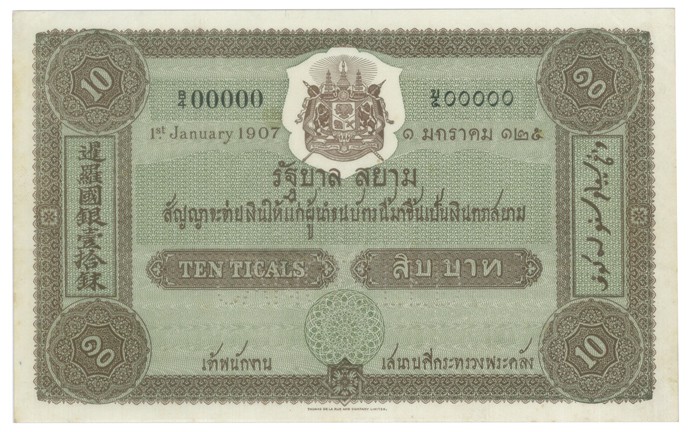
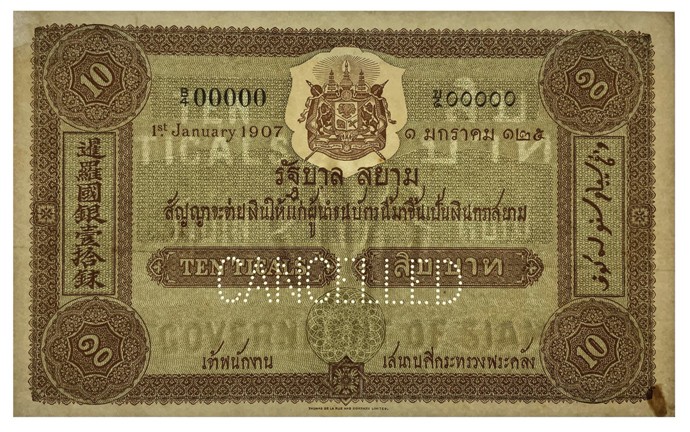
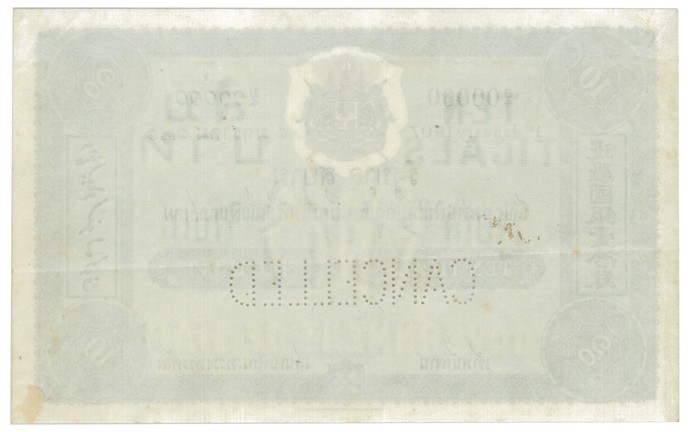
10 Tical 1st January 1907 with numerals with single outline, unapproved watermark
In early November, TdlR informed The Minister of Finance, Mr Rivett-Carnac and later the Siamese Minister in London that they had experimented in producing a small lot of banknote paper. The watermark was somewhat altered and made solid instead of a double outline. One of the difficulties with the present notes was that the watermark falls upon the dark tablets and makes it very indistinct. For this reason, the watermark was moved to another position so the dark tablets would not cover the watermark.
TdlR attached the cancelled specimen 10 Tical with the experimental watermark for comparison. TdlR would do the alteration of the watermark free of charge. In my collection I have two of the specimen banknotes with the experimental watermark. On one of these notes, prefix and number are omitted. The other has the prefix B/4, the same as on the rejected notes which were replaced and the number 00000. The reason for using B/4 is that this prefix had just been used on the replaced notes and was at hand.
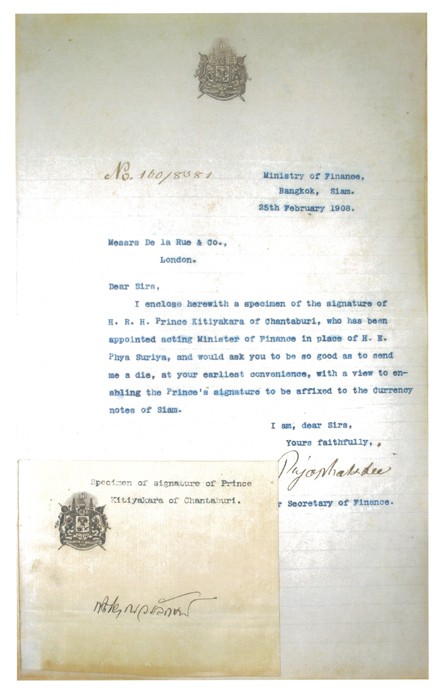
Letter with the specimen of signature of Prince Kittiyakara of Chantaburi
In a letter dated 25th February 1908, the Ministry of Finance informed TdlR that His Royal Highness Prince Kittiyakara was appointed acting Minister of Finance. A specimen of his signature was enclosed and TdlR was asked to send a die with this signature as it was to be affixed on the currency notes of Siam. The price for this steel signature die was GBP 4. For security reasons, the banknotes were shipped from England with numbers but the signatures were added in Thailand.
The Minister of Finance, H.R.H. Prince Kittiyakara, wrote a letter on 24th April 1908 to follow up on the 20 Tical banknotes with defective watermark referring to his predecessor’s letter of 25th April 1907. The Paper Currency Office had by then inadvertently put a considerable number of the defective notes in circulation.
The Minister of Finance informed TdlR that the Currency Office managed to retrieve 89,000 pieces, so they would be glad if TdlR would be so good to replace them free of charge in the same way they did with regards to the 10 Tical notes. The notes to be replaced had prefix C/2 and number 36001 to prefix C/3 number 25000. TdlR confirmed that they would replace the 89,000 defective 20 Tical notes, but would not be able to despatch them for about three months as the paper had to be produced.
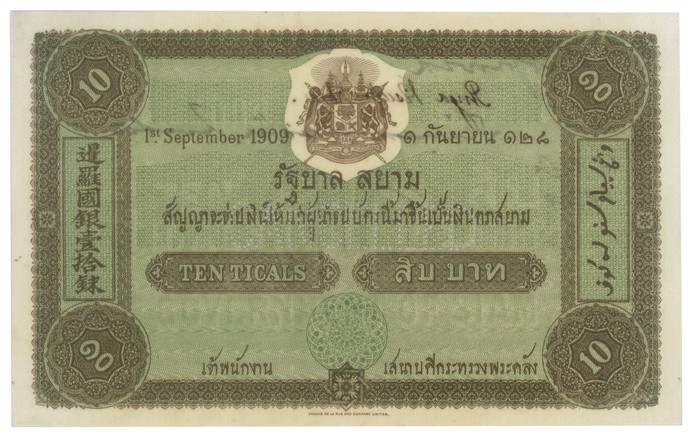

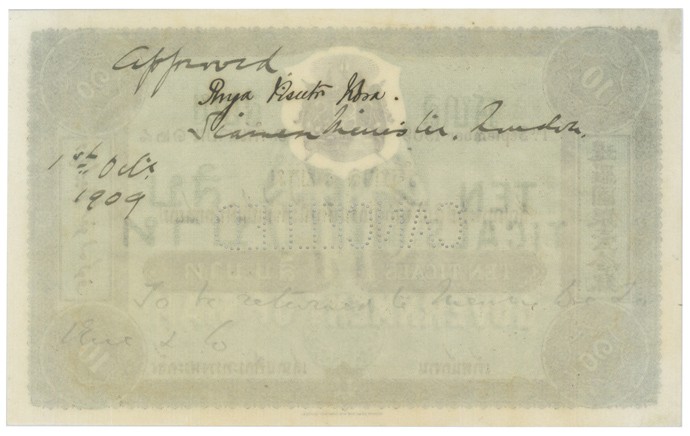
10 Tical 1st September 1909 with solid numerals watermark and with annotation on the back as approved by The Minister of Siam to the United Kingdom, H.E. Phya Visutr Kosa.
The Minister of Finance informed TdlR on the 25th of April 1908 that the experimental specimen notes sent in early November last year with the altered watermark should be changed. He agreed that the watermark was to be made solid instead of outlined as was being done at present. The positions of the value in printed English and Thai should be reversed. The Thai value should be on top and the English value below. The 10 Tical experimental specimen banknote was returned to TdlR in the letter.
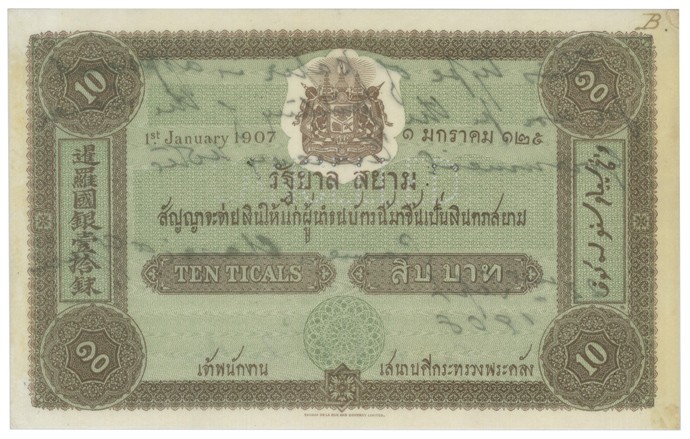
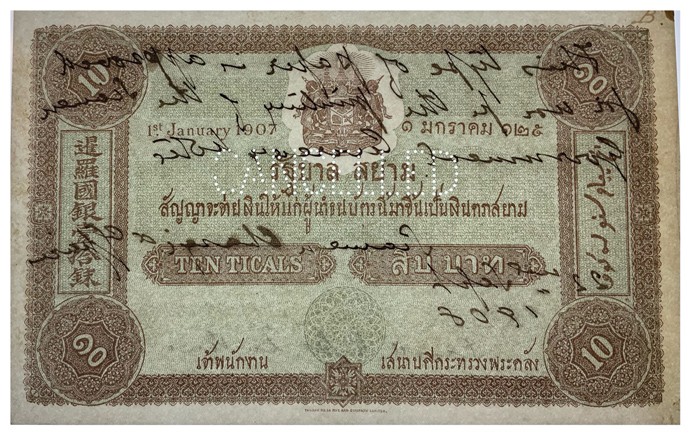
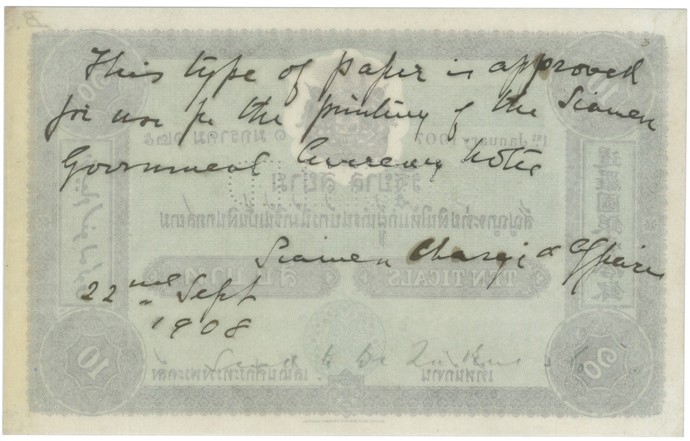
10 Tical specimen 1st January 1907 produced on paper without watermark. On the reverse is the notation by the Siamese Charge the Affaires.
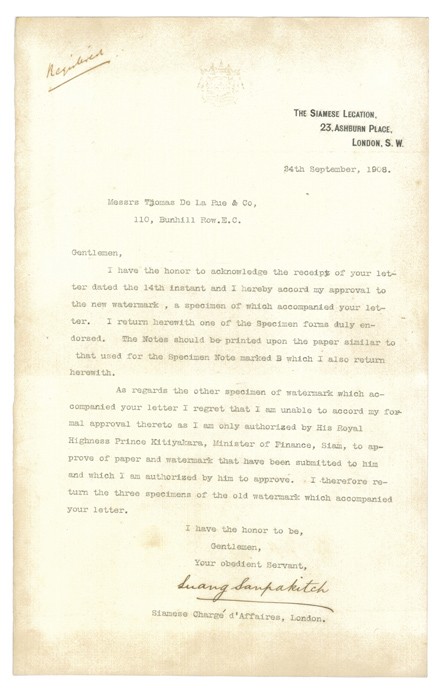
Original letter from The Siamese Legation informing that the paper was approved.
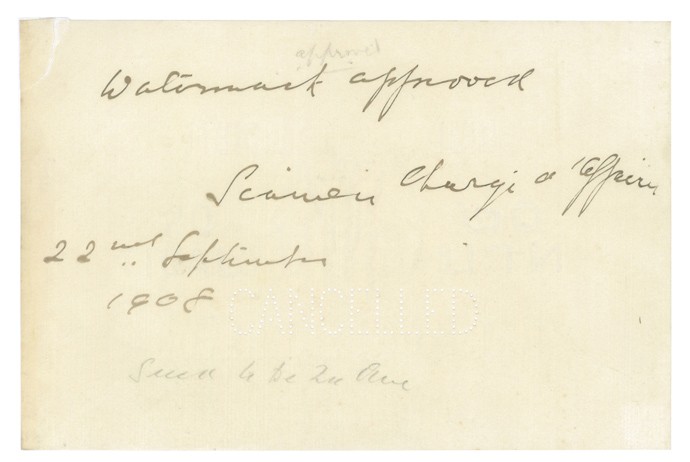
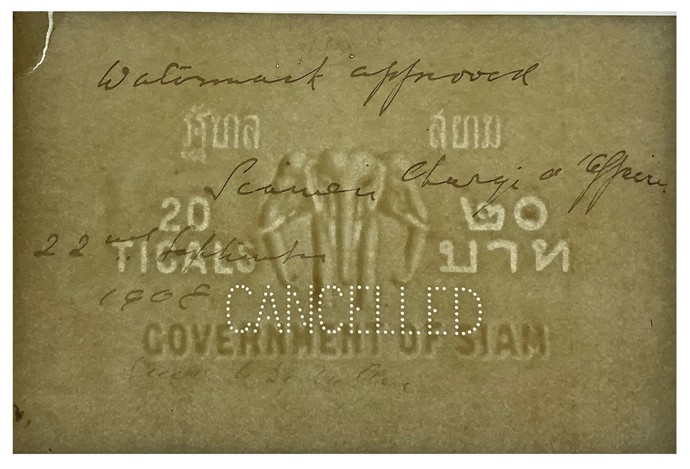
Approved watermarked paper with solid values
On the 1st of June 1908, TdlR confirmed that they would carry out the instructions by making the values in the watermark solid. The new paper would come into use when the existing paper with outlined stock was exhausted. In September, the stock of the original outlined paper went from 2,000 for the 100 Tical and as much as 80,000 for the 5 Tical.
It was confirmed on the 24th of September 1908 by the Siamese Legation in London that notes should be printed on similar paper marked as the 10 Tical note marked “B” in the upper right margin. The specimen note was printed without watermark, as the watermarked paper was expensive to produce and at the time not produced by TdlR. The Siamese Charge de Affaires did not have the authorisation to approve the old watermark enclosed by the Minister of Finance in Bangkok. However, he had the authorisation to approve the new watermarked paper with solid values.
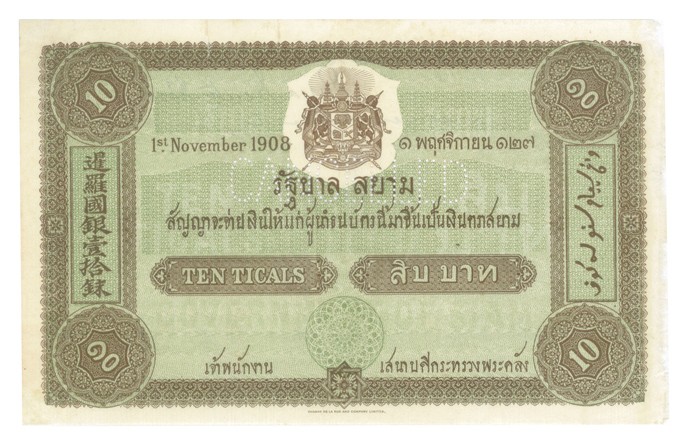
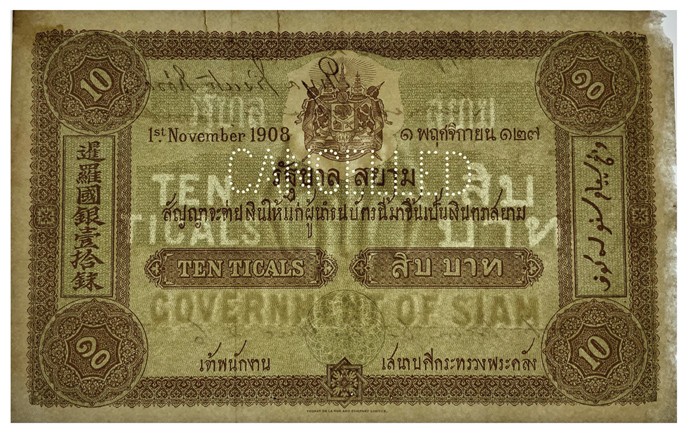
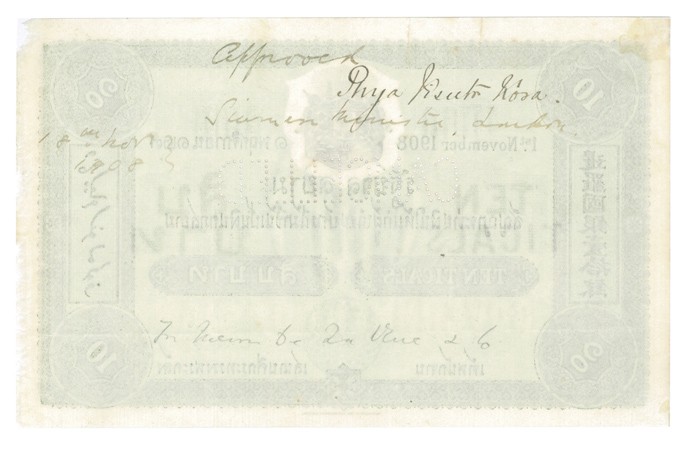
10 Tical 1st November 1908 with solid numerals watermark and with annotation on the back as approved by The Siamese Minister to the United Kingdom, H.E. Phya Visutr Kosa.
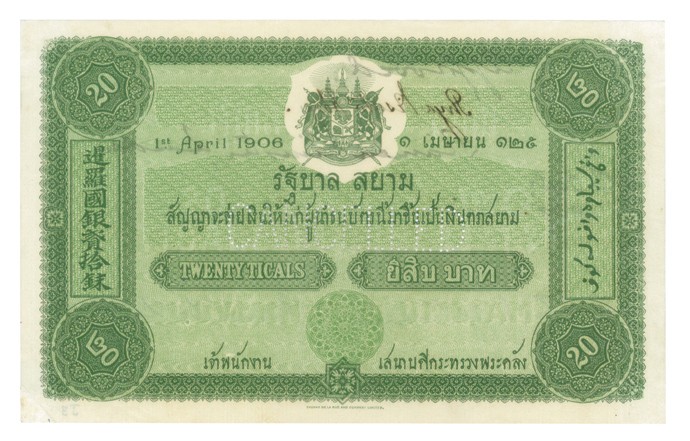
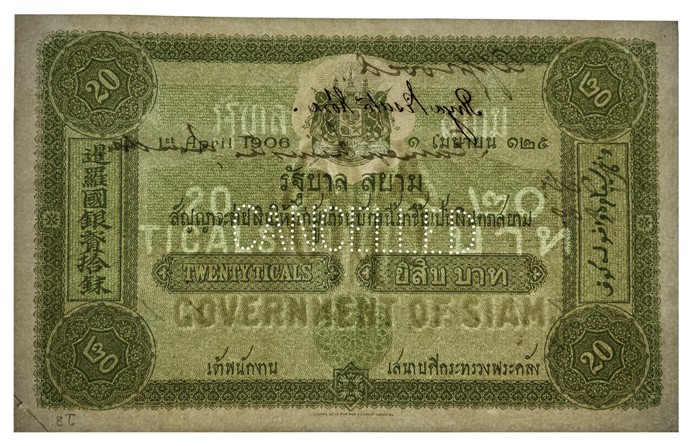
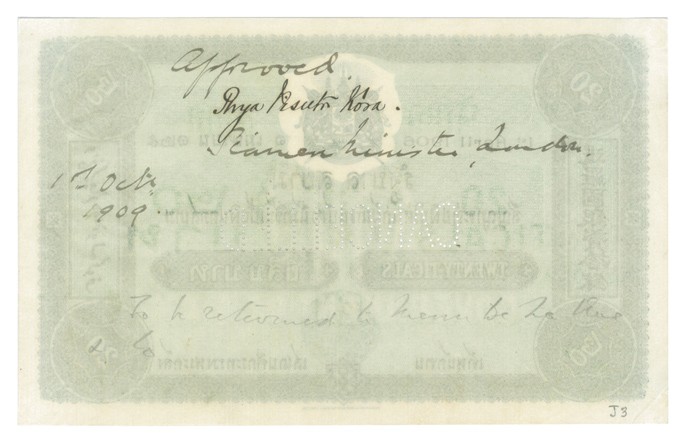
20 Tical 1906 with solid values watermark and micro printing
On 23rd of October 1908, the Siamese Minister in London enquired as to why a 20 Tical 1st of April 1906 was sent to him for approval. The Minister was of the opinion that it was more appropriate that this issue, being distinct from the former issue, should have its own special date. TdlR replied immediately that this was a sample of the substitution of some of the defective Notes, which were rejected by the Siamese Government.
Therefore they were to bear the date of 1st April 1906, the same as the rejected notes. The Minister in London approved the Note and authorised TdlR to proceed with the work. The first consignment of the 50,000 replacement notes was shipped per S.S. “Kawachi Maru” on 8th November 1907. The second and final shipment of the 39,000 replacement notes was done on 20th December 1907 per S.S. “Tambu Maru”.

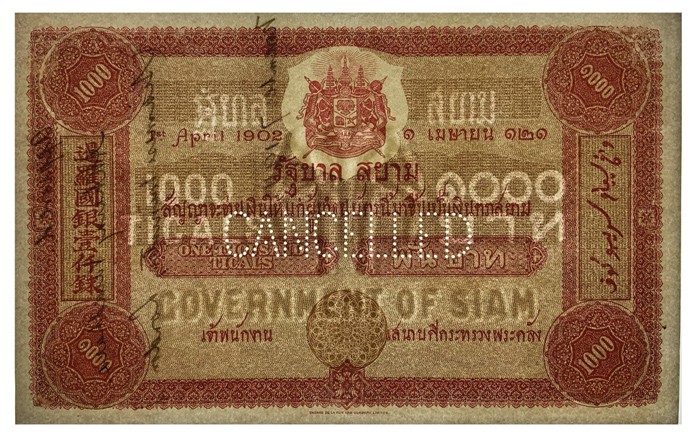
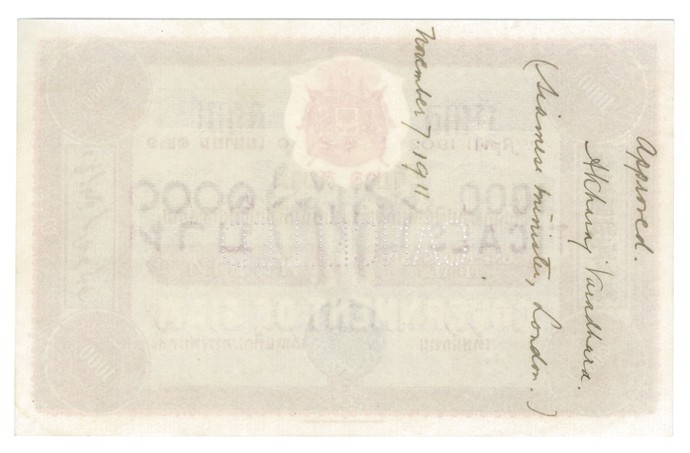
1000 Tical 1902 approved and signed by H.E. Phya Buree Nawarai, Siamese Minister in London to the United Kingdom on 7th November 1911 with solid values.

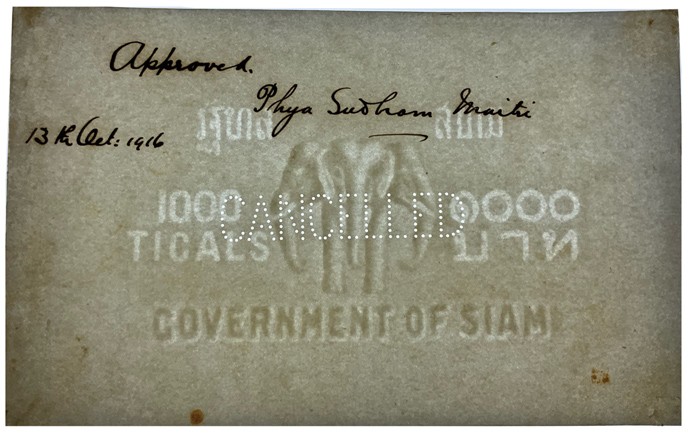
Watermarked paper with solid values approved by H.E. Phya Sudham Maitri, Siamese Minister of Thailand to the United Kingdom.
On the 16th September 1905, TdlR despatched 10,000 pieces of the 1000 Tical Banknotes to Thailand. The Minister of Thailand to the United Kingdom informed TdlR in a letter on the 5th of January 1909 that these notes were printed too thick. The Minister of Finance requested TdlR to despatch at their earliest convenience a fresh consignment with similar numbers. These notes were shipped on the 8th of February 1909 per S.S. “Kanagawa Maru”. The 1000 Tical is the rarest denomination of the First Series.
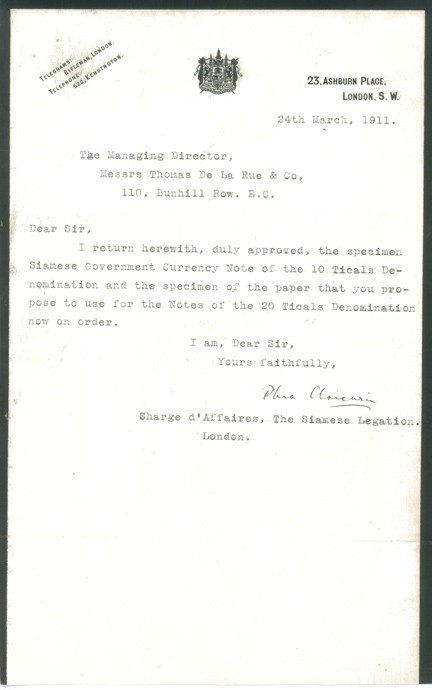
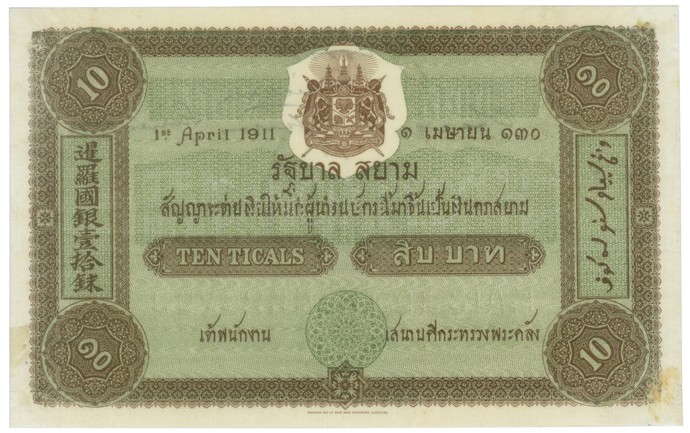
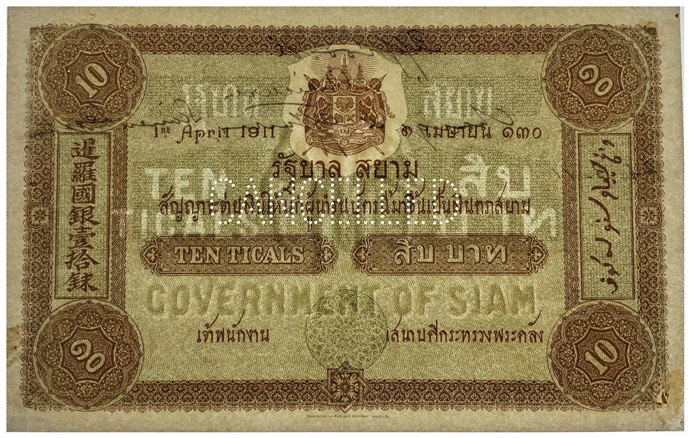
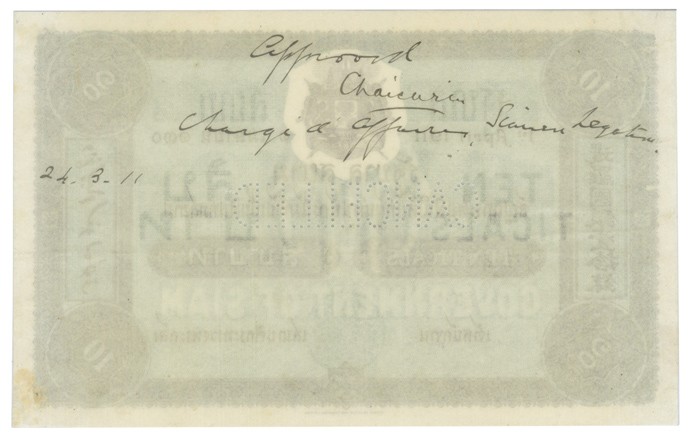
Letter from Siamese Legation, London dated 24th March 1911. 10 Tical specimen banknote dated 1st April 1911 and watermarked paper for 20 Tical. Both signed and approved by the Charge de Affaires 24th March 1911, solid numerals. An example of a letter sent with approved banknote and watermarked paper to TdlR from the Siamese Legation in London.
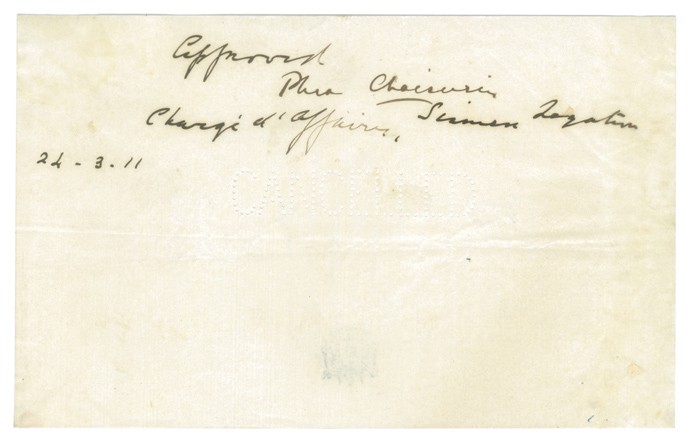
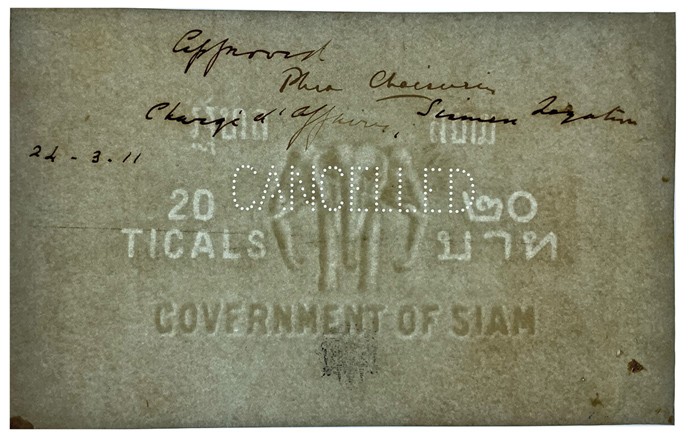

It is interesting to see the importance of the watermark during that period as prevention against forgeries. The Minister of Finance contacted TdlR in December 1908 concerning a cutting from “Stationery Trades Journal” concerning Mr N. S. Amstutz “Akretone Engraving Machine” to reproduce watermark without Photographic means.
TdlR replied to the Minister of Finance that watermarks produced on this machine were worthless, because if the paper were soaked in water the fictitious watermark disappeared entirely.
Mr N. S. Amstutz did write a book in 1907 titled, “Handbook of Photoengraving”. Photoengraving had a big impact on the production of banknotes. Watermarked paper was at the time very important to prevent forgeries, but there were other features, like secret marks and the micro printing of the denominations.
For the First Series banknotes the denomination Ticals was used in English while Baht were used in Thai. The reason is that Tical was better known to foreigners trading in the region. Tical and Baht is also a unit of mass. In the English correspondence between the printer of the Siamese Banknotes, Thomas de la Rue & Company Limited London and The Siamese Legation in London, Siamese Ministry of the Royal Treasure and the Ministry of Finance, Tical was used for the denomination of the First Series banknotes.
References:
-The archives of Thomas de la Rue & Company, Limited, London
-Bank of Thailand, “Centenary of Thai Banknotes: 1902 – 2002”
-Somchai Saeng-ngern, “Thai Banknotes Catalogue, Complete and Updated Edition”
-All illustrations from Jan Olav Aamlid collection
Copyright © 2021 All rights reserved by Jan Olav Aamlid





